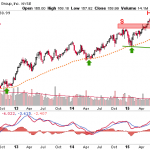
In March 2017, employers across the US added 98,000 new jobs. While positive, it falls shy of the 180,000-level forecast by analysts. This also marks the end of a 2-month run of gains for jobs growth in the country. The jobless rate is now at its lowest level in 10 years, and it shifts the focus back to the Fed vis-à-vis interest rate policy. The US unemployment rate also dropped from 4.7% to 4.5%, indicating that the economy is running red hot under full employment conditions. Since the end of 2015, the Fed has hiked interest rates 3 times, and this latest data is likely to tighten the screws on the Fed’s policy of further rate hikes for a while.
The jobs numbers were quickly injected into the political debate with Democrats blaming Trump for disappointing jobs growth and Republicans wanting none of it. This figure represents the slowest jobs growth rate since May 2016. Year on year wage growth decreased from 2.8% to 2.7% accordingly. According to the Atlanta Federal Reserve Bank, it is possible that the US economy shrank from a growth rate of 2.1% in Q4 2016 to a growth rate of 1.2% in Q1 2017. This is the lowest unemployment rate in the US for 10 years, and that bodes well for lesser demands on government for unemployment benefits, but slow jobs growth remains a concern.
Trading opportunity #1 – Dow Jones Weaker on Jobs Growth Figures

Friday’s disappointing jobs figures naturally influenced US bourses. The Dow Jones Industrial Average has been battered by a combination of the US missile strike on Syria when 59 cruise missiles smashed a Syrian runway that was used in a chemical weapons attack against civilians, and by the US jobs report which reflected the addition of just 98,000 new jobs when 180,000 new jobs were expected. The above chart reflects the stagnating performance of the Dow Jones, from having broken through the critical 21,000 level and slowly retreating towards the 20,600 level. If the US orders new strikes against Syria, or if tensions with North Korea worsen, we are likely to see a further weakening of the Dow Jones.













Leave A Comment